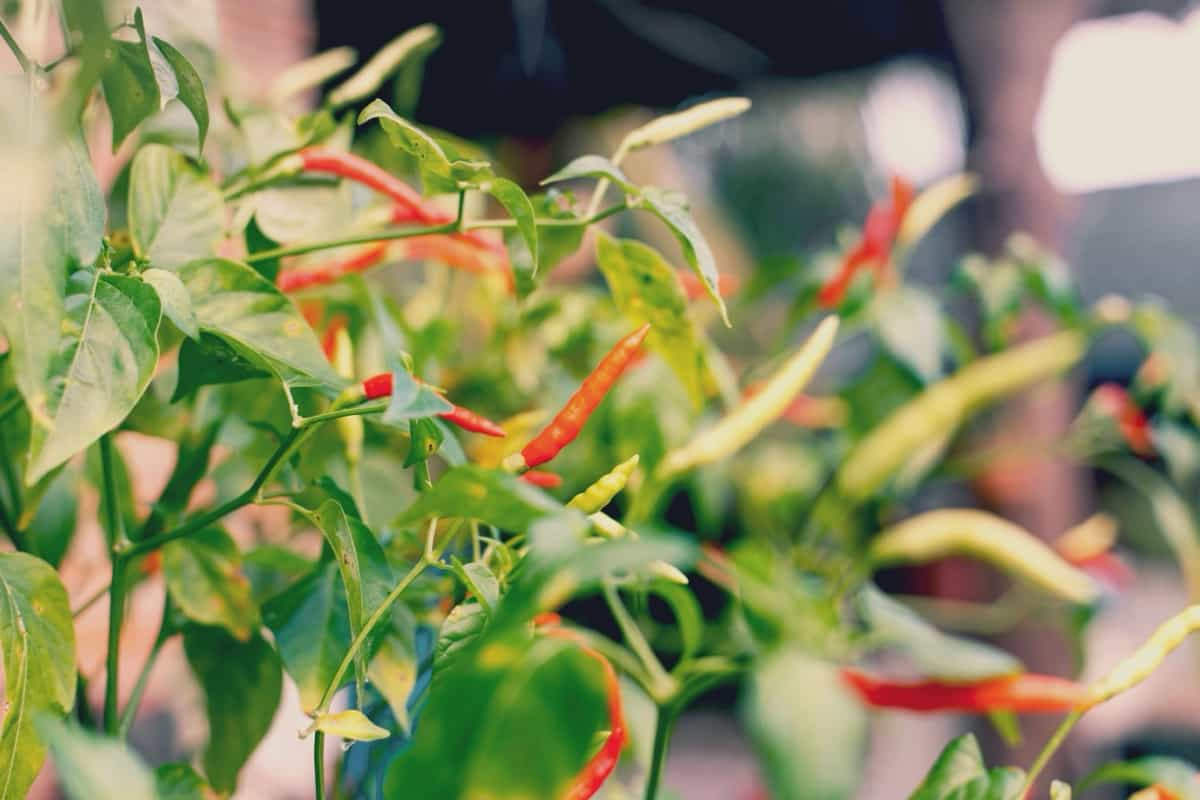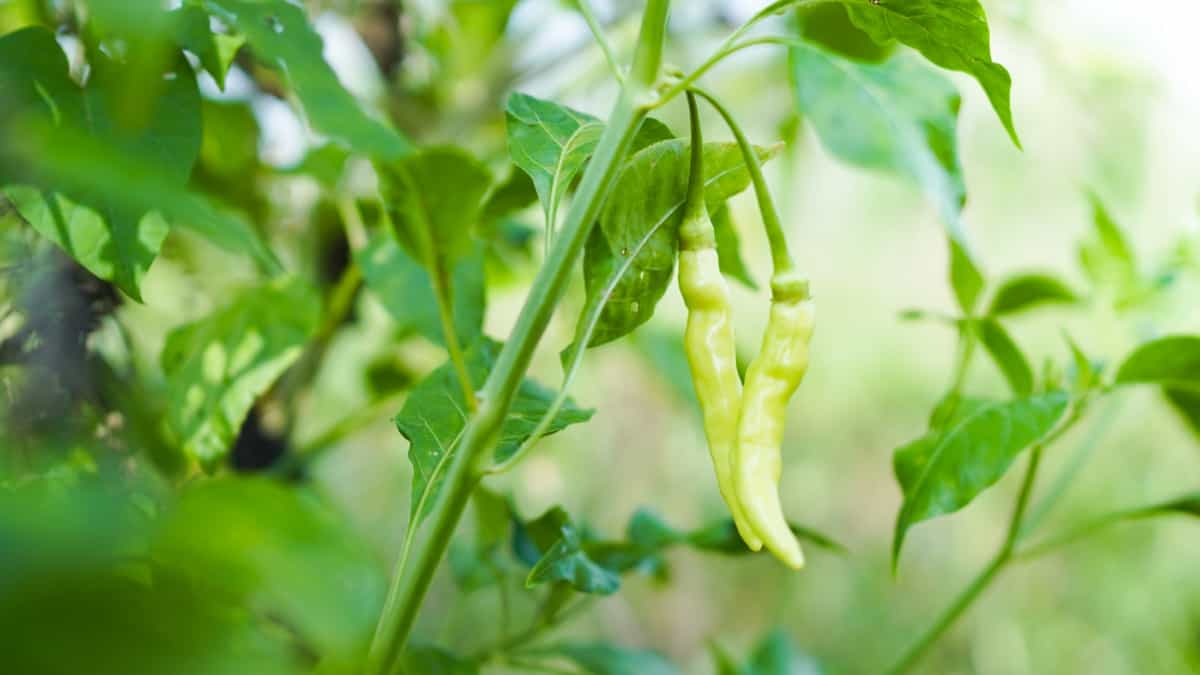When it comes to growing Chilli plants, every gardener dreams of a bountiful harvest and fiery peppers. However, viral diseases can quickly turn this dream into a nightmare. These microscopic pathogens infiltrate the plant’s cells, causing various symptoms that can significantly impact its growth and productivity.

Viruses are not like bacteria or fungi; they cannot be seen with the naked eye. They are tiny particles made up of genetic material wrapped in a protein coat. Due to their minuscule size, they easily spread from infected plants to healthy ones through vectors such as insects, nematodes, or even contaminated tools used for pruning.
Top 10 Viral Diseases in Chilli
Chilli Mosaic Virus
Chilli Mosaic Virus is a common viral disease that affects Chilli plants, causing significant damage to their growth and productivity. This virus is primarily transmitted through aphids or by using infected plant material. The symptoms of the Chilli Mosaic Virus are quite distinct, with mosaic-like patterns appearing on the leaves. These patterns are characterized by light green or yellow patches, which can later turn into brown necrotic areas. The affected leaves may also exhibit curling or distortion.
Controlling this virus involves employing preventive measures like crop rotation, regular inspection for aphids, and removal of infected plants. Applying insecticides can help reduce aphid populations and minimize virus transmission. Treating the Chilli Mosaic Virus is challenging since there are no specific chemicals available for its eradication once an infection occurs. However, good cultural practices like maintaining proper hygiene in the field and using disease-free seeds can help prevent further spread.
Tobacco Streak Virus
The tobacco Streak Virus is a viral disease that affects Chilli plants, causing significant damage to their growth and productivity. Once infected, Chilli plants with the Tobacco Streak Virus exhibit distinct symptoms. One of the most noticeable symptoms of the Tobacco Streak Virus is streaking or discoloration on the leaves. These streaks can range in color from yellow to brown, giving the affected leaves a mottled appearance. In addition to leaf discoloration, infected Chilli plants may also show stunted growth and reduced fruit production.
Diagnosing the Tobacco Streak Virus can be challenging as its symptoms can resemble those caused by other viruses or environmental factors. To control and treat the Tobacco Streak Virus in Chilli plants, it’s important to implement preventive measures. These include practicing good sanitation by removing infected plant debris and controlling thrip populations through insecticide applications or biological control methods.
Chilli Veinal Mottle Virus
Chilli Veinal Mottle Virus is a viral disease that affects Chilli plants, causing significant damage to their growth and overall health. This virus is primarily transmitted through infected seeds or by various insect vectors such as aphids and whiteflies. One of the most noticeable symptoms of the Chilli Veinal Mottle Virus is the appearance of yellowish patches or mottling on the leaves, which are typically accompanied by vein clearing.
In case you missed it: How to Prevent Chilli Fruit Rot Naturally: How to Control with Natural and Organic Treatment

In severe cases, the leaves may become distorted and display a crinkled appearance. These visual cues can help distinguish this virus from other common diseases affecting Chilli plants. Preventing and managing the Chilli Veinal Mottle Virus involves several measures. It’s crucial to start with using disease-free seedlings and practicing good sanitation in your garden or farm. Implementing proper weed control strategies can also help reduce potential sources of infection.
Cucumber Mosaic Virus
It gets its name because it was first identified in cucumber plants, but it can also infect other crops like Tomatoes and Peppers. One of the most distinctive symptoms of the Cucumber Mosaic Virus is mosaic-like patterns on the leaves, where light green or yellow patches appear alongside normal green areas. These mottled leaves can ultimately lead to stunted growth and reduced yield.
The best approach is prevention through good cultural practices such as removing infected plants promptly and controlling aphid populations using insecticides or natural predators. Plant breeders are also working towards developing resistant varieties to combat the Cucumber Mosaic Virus effectively. By selecting Chilli cultivars with natural resistance to the virus, farmers may be able to reduce their losses significantly.
Tomato Spotted Wilt Virus
Tomato Spotted Wilt Virus is a serious viral disease that affects Chilli plants. It is transmitted by thrips, tiny insects that feed on plant sap. Once infected, the virus causes dark green or bronze spots on the leaves, which eventually turn yellow and wilt. The virus can also affect the fruits, causing brown streaks and rings. Diagnosing tomato-spotted wilt virus can be challenging as its symptoms are similar to other viral diseases in Chillies.
Controlling and treating Tomato Spotted Wilt Virus requires an integrated approach. Start by practicing good cultural practices such as removing infected plants promptly to prevent further spread of the virus. Use insecticides to control thrips populations, but be cautious not to harm beneficial insects like bees. Additionally, regularly monitor your plants for any symptoms of infection so you can take immediate action if needed.
Chilli Ringspot Virus
Chilli Ringspot Virus is a viral disease that affects Chilli plants and can cause significant damage to crops. This virus is transmitted by insects, such as aphids, which spread the virus to healthy ones. Symptoms of Chilli Ringspot Virus include dark green rings or spots on the leaves, as well as stunted growth and reduced yield. Infected fruits may also develop ringspots or become distorted in shape.
To control and prevent the spread of the Chilli Ringspot Virus, it is important to implement proper sanitation practices in your garden or farm. This includes removing infected plants and controlling insect vectors through regular monitoring and insecticide applications if necessary. Unfortunately, there are no known treatments for Chilli Ringspot Virus once a plant becomes infected. Therefore, prevention is key to managing this disease effectively.
In case you missed it: 10 Common Problems With Green Chilli Plants: Treatment and Solutions

Pepper Mild Mottle Virus
Pepper Mild Mottle Virus is a common viral disease that affects Chilli plants. The symptoms of Pepper Mild Mottle Virus infection include mottled leaves with light and dark green patches, stunted growth, and distorted fruit development. Infected plants may also exhibit necrotic lesions on their stems and petioles. Pepper Mild Mottle Virus is transmitted through infected seeds or by insect vectors such as aphids and whiteflies. It can also spread through mechanical means like pruning tools or contaminated hands.
To control the Pepper Mild Mottle Virus, it is important to start with disease-free seeds or transplants. Regular scouting for aphids and whiteflies should be carried out, and if detected, appropriate insecticides can be used to manage their populations. Crop rotation practices can help reduce the build-up of the virus in the soil. Although there are no specific treatments for Pepper Mild Mottle Virus-infected plants, maintaining overall plant health through proper watering, nutrition management, and pest control measures can help alleviate its impact.
Chilli Leaf Curl Virus
Chilli Leaf Curl Virus is a common viral disease that affects Chilli plants. It is primarily transmitted by whiteflies, which feed on the infected plants and then spread the virus to healthy ones. Once infected, Chilli plants exhibit distinct symptoms such as curling and twisting of leaves, stunted growth, and yellowing of veins. The virus interferes with the normal growth and development of the plant, resulting in reduced yield and poor fruit quality. Infected plants may also produce deformed or misshapen fruits.
Controlling the Chilli Leaf Curl Virus requires a multi-faceted approach. First and foremost, it’s important to prevent whitefly infestations by regularly monitoring your plants for signs of these pests. If detected early, physical removal or application of insecticidal soap can help eliminate them. Additionally, practicing good sanitation measures such as removing infected leaves or uprooting severely affected plants can help prevent further spread of the virus within your garden. Incorporating resistant varieties into your planting strategy can provide some level of protection against this viral disease.
Potato Virus Y
Potato Virus Y is a viral disease that affects not only Potatoes but also Chillies. One of the main symptoms of Potato Virus Y in Chilli plants is leaf mosaic, where the leaves develop irregular patterns of light and dark green patches. This mosaic pattern can be quite distinct and easily recognizable. Infected plants may also exhibit stunted growth, distorted leaves, and reduced fruit production.
To control and treat Potato Virus Y in Chilli plants, it’s crucial to implement integrated pest management strategies. This includes regularly monitoring aphid populations and taking appropriate measures to manage them effectively. Additionally, removing infected plants from the field or greenhouse can help prevent further spread. Using certified disease-free seeds or transplants is another preventive measure against Potato Virus Y infection. Proper sanitation practices, such as disinfecting tools between use, can also reduce transmission risks.
Chilli Distorted Leaf Disease
Chilli Distorted Leaf Disease is a viral disease that affects Chilli plants, causing deformities in the leaves. The disease is characterized by curling and twisting of the leaves, resulting in a distorted appearance. This can severely affect the growth and productivity of Chilli plants. The symptoms of Chilli Distorted Leaf Disease include upward curling of the leaf margins, yellowing or mottling of the leaves, stunted growth, and reduced yield. Infected plants may also show puckering or blister-like formations on the surface of the leaves.
In case you missed it: Homemade Chilli Pepper Spray for Pests and Disease Control: Recipe for Natural and Organic Benefits of Plants

Controlling and treating Chilli Distorted Leaf Disease involves various measures. It is crucial to practice proper sanitation by removing infected plant material from the field and destroying it properly. Additionally, using virus-free seeds or seedlings can help prevent further spread of the disease. Applying appropriate insecticides to control aphid populations can reduce the transmission of viruses that cause Chilli Distorted Leaf Disease.
Conclusion
Viral diseases can pose a significant threat to the health and productivity of Chilli plants. Growers must be aware of the common symptoms and diagnosis methods for identifying viral infections in their crops. By implementing effective control measures and treatment options, it is possible to mitigate the impact of these diseases on Chilli plants. By staying informed about the latest research developments in virus management strategies specific to Chillies, growers can stay ahead of potential threats and ensure successful harvests year after year.
- Feed Your Flock for Less: Top 10 Tips to Save on Chicken Feed
- Ultimate Guide to Ossabaw Island Hog: Breeding, Raising, Diet, and Care
- Hatching Answers: The Top 10 Reasons Your Chickens Aren’t Laying Eggs
- Eggs and Economics: Breaking Down the Cost of Raising Backyard Chickens
- Defend Your Greens: Proven Methods to Keep Iguanas Out of Your Garden
- Ultimate Guide to Cinnamon Queen Chicken: A Comprehensive Guide for Beginners
- Ultimate Guide to California Tan Chicken: Breeding, Raising, Diet, Egg-Production and Care
- Ultimate Guide to Marsh Daisy Chicken: Breeding, Raising, Diet, and Care
- 10 Types of Chicken Farming Businesses You Can Start for Profits